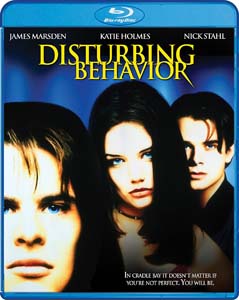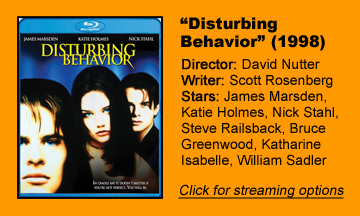In 1998, I thought “Disturbing Behavior” was an elite portrayal of high school as a conformity factory, as that concept was a new discovery for me at the time. While the theme is now old hat, the movie still makes me smile as it meets at the intersection of blunt metaphor and derivative sci-fi warning but comes off as a dark comedy.
It features a dizzying variety of performances in a tight 84 minutes, cut down by the studio into almost a trailer of itself. It’s a crystallization of 1998 (flannel), yet it exists in a parallel reality (“razor”). It’s not objectively great – and I can see why some people hate it — but it’s so fun to watch.
Rosenberg, Nutter team up
The quality of writer Scott Rosenberg’s credits range all over the place, but they include tons of stuff you’ve heard of. Most impressive is “High Fidelity” (2000), but most relevant for this discussion is 1997’s “Con Air,” a nonsensical action romp that has the type of cult following “Disturbing Behavior” also deserves.
“DB” is the film that lured “The X-Files’ ” David Nutter away from TV directing and then had him running back to TV directing; he’d helm the “Roswell” pilot the following year. He hates the studio-mandated theatrical cut.
Featuring a creepy score by “The X-Files’ ” Mark Snow, “DB” captures the experience of people trapped in a weird town except that Mulder and Scully never show up to make sense of it. Although everyone lives in Cradle Bay, Wash. – accessible only by ferry — every actor is in a different movie.
James Marsden plays it straight as new kid Steve. I can’t decide if Katie Holmes, as Rachel, is tired from her “Dawson’s Creek” shooting schedule and fame, or because Rachel is beaten down by this town and by having football player Chug (A.J. Buckley) constantly ask her out.
Nick Stahl plays Gavin like he’s the first conspiracy theorist in history. Chad E. Donella plays stoner U.V. like someone who’s never been stoned. William Sadler gives a thankless turn as the school janitor who’s only pretending to be mentally challenged (Newberry notes that you can learn a lot about human behavior when people think you’re stupid).
A simple scheme
The villainous mad doctor, Bruce Greenwood’s Caldicott, has a simple scheme: His implant chips – in the form of contact lenses — drive the bad behavior out of hormone-driven teenagers, turning them into 1950s malt-shop kids (or at least that stereotype) called Blue Ribbons.
But the teens’ hormones overpower their chip a lot. Blue Ribbon girl Lorna (Crystal Cass) tries to seduce Steve but bashes her head into a mirror and mutters “Bad wrong, wrong bad,” then departs – face bloodied – because she has to study for tomorrow’s big test. Chug, rejected by Rachel, screams “Why not?!” and twitches spasmodically.
In an era when “Buffy” was portraying high school as hell and inventing new words, Rosenberg takes a crack at tweaking the language. He tries oh so hard to make “razor” happen – Rachel says this slang word for “cool” three times. Yet there’s no doubt this is the 1990s, especially notable by the plaid flannel favored by Steve and his kid sister Lindsay (Katharine Isabelle).

“DB” achieves a so-uncool-it’s-cool quality largely through its soundtrack. The Flys’ “Got You Where I Want You” is the decade’s quintessential song of longing for the girl who doesn’t like you back – as exemplified by Holmes in the music video, where she’s loosely in character as Rachel, flinging the pestering Blue Ribbons off a cliff.
Different ideas
This is a prime example of a film where no two cast, crew or marketing people have the same idea about what it is. To cite another example, the novelization is written at a juvenile-reader level, even though the movie is not suitable for kids picking up the first “Harry Potter.”
It’s maybe OK for the “Hunger Games” set, except it treats the quashing of teens’ individuality as dark comedy, and I find it hard to imagine millennials or Gen-Z kids finding this movie clever.
Nonetheless, the disparate ingredients come together into a tasty distillation of teen-rebellion-genre history firmly planted in 1998. As I learn more about cinema and pop-culture history, I recognize that 1990s teens were not the first to realize the education system shuffles them into a socio-economic-political system that resists free thought. We’re not as special as I like to think.
That said, there’s something poignant about Steve and Rachel running from Caldicott’s lab techs and conformist classmates, knowing that their parents either turned them in to the mad doctor (Steve’s) or never existed in the film at all (Rachel’s).
It’s not paranoia if they’re really out to get you, and in the wacko world of “Disturbing Behavior,” this ancient notion becomes eye-opening again.


